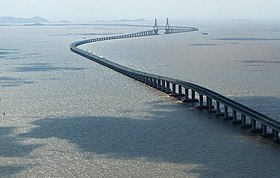This article needs additional citations for verification. (January 2021) |
Transport in China has experienced major growth and expansion in recent years. Although China's transport system comprises a vast network of transport nodes across its huge territory, the nodes tend to concentrate in the more economically developed coastal areas and inland cities along major rivers.[1] The physical state and comprehensiveness of China's transport infrastructure tend to vary widely by geography. While remote, rural areas still largely depend on non-mechanized means of transport, urban areas boast a wide variety of modern options, including a maglev system connecting the city center of Shanghai with Shanghai Pudong International Airport. Airports, roads, and railway construction will provide a massive employment boost in China over the next decade.
Much of contemporary China's transport systems have been built since the establishment of the People's Republic in 1949. The railway, which is the primary mode of long distance transport, has seen rapid growth reaching 139,000 km (86,371 mi) of railway lines making it the second longest network in the world (2016).[2][3] Prior to 1950, there were only 21,800 km (13,546 mi) of railway lines. The extensive rail network includes the longest and busiest HSR network in the world with 35,000 km (21,748 mi) of high-speed lines by year end 2019.[4][3] While rail travel remained the most popular form of intercity transport, air travel has also experienced significant growth since the late 1990s. Major airports such as Beijing Capital International and Shanghai Pudong International being among the busiest in the world. At the end of 2017,[5] there are some 34 metro systems in operation across China, including some of the largest and busiest subway networks in the world. Of the 12 largest metro networks in the world by length, seven are now in China.[6] Additionally, many bus rapid transit, light rail and rapid transit lines are currently under construction, or in the planning stages across the country. The highway and road system also has gone through rapid expansion, resulting in a rapid increase of motor vehicle use throughout China. A government-led effort started in the 90s to connect the country by expressways via the National Trunk Highway System has expanded the network to about 97,000 km (60,273 mi) by the end of 2012[7] making China's the longest expressway network in the world.
- ^ Fengbo, Zhang. Economic Analysis of Chinese Transportation.
- ^ China Statistical Yearbook 2016 "Length of Transport Routes at Year-end by Region (2015)" Accessed 2017-02-16
- ^ a b "Factbox: Highlights of China's comprehensive transport network - Xinhua | English.news.cn". www.xinhuanet.com. Retrieved 2021-01-11.
- ^ "China's high-speed rail tracks to hit 38,000 km by 2025- Xinhua | English.news.cn". news.xinhuanet.com. Archived from the original on January 2, 2018. Retrieved 25 April 2018.
- ^ Cite error: The named reference
corgwas invoked but never defined (see the help page). - ^ "In response to growth, Chinese cities choose metros". The Transport Politic. 2018-01-17. Retrieved 2018-07-31.
- ^ "Chinese highways for fast traffic add up to 65,000 km (40,389 mi) - Chinadaily".


